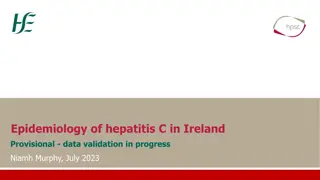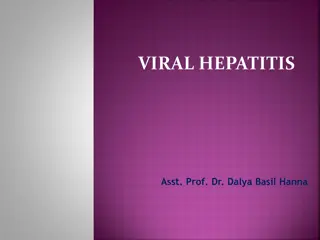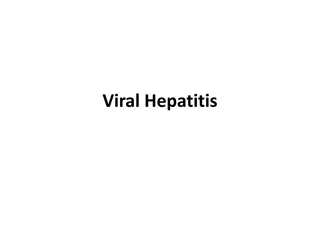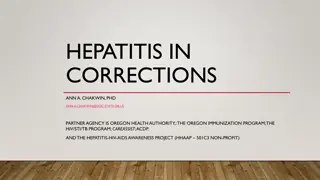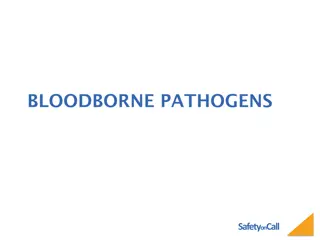Hepatitis A: Causes, Symptoms, and Management
Hepatitis A (HAV) is a liver inflammation caused by contaminated food or water, anal/oral sex, and poor hygiene. Incidence rates vary by age, race, and sex. Risk factors include international travel and drug use. Symptoms include dark urine, fatigue, and jaundice. Diagnosis involves blood tests, and treatment focuses on symptom relief and vaccination. Effective management involves lifestyle changes and minimizing exposure to others. For more information, refer to reputable sources such as CDC, eMedicineHealth, and Mayo Clinic.
Download Presentation

Please find below an Image/Link to download the presentation.
The content on the website is provided AS IS for your information and personal use only. It may not be sold, licensed, or shared on other websites without obtaining consent from the author.If you encounter any issues during the download, it is possible that the publisher has removed the file from their server.
You are allowed to download the files provided on this website for personal or commercial use, subject to the condition that they are used lawfully. All files are the property of their respective owners.
The content on the website is provided AS IS for your information and personal use only. It may not be sold, licensed, or shared on other websites without obtaining consent from the author.
E N D
Presentation Transcript
Hepatitis A (HAV) (WHO) Liver Inflammation 1 of 5 Main Hepatitis Viruses Causes (NIH) Contaminated food/water Anal/Oral Sex with someone with HAV Not washing hands after changing a diaper
Incidence (CDC) 2006: 1.2/100,000 2010: 0.5/100,000 Demographics (CDC) Age Groups (2008) =<44 years: 0/100,000 =>45 years: 0.30/100,000 Race (2008) Whites: 0.02/100,000 Blacks: 0.04/100,000 Sex (2008) Male: 0.03/100,000 Female: 0.02/100,000
Risk Factors (PubMed Health) International Travel IV Drug Use Nursing Homes/Rehabilitation Centers Healthcare/Food/Sewage Industry Symptoms (PubMed Health) Usually 2-6 weeks after exposure to HAV virus Dark Urine Fatigue Itching Loss of Appetite Nausea and Vomiting Yellow Skin (Jaundice)
Diagnosis (eMedicineHealth) Blood Test Test for Antibody Treatment (eMedicineHealth) No formal treatment Symptoms-relieving medications Vaccine (Immune Serum Globulin) Recommended within 2 weeks of exposure
Tools for effectively managing HAV Fewer activities Water and fruit juices Healthy food No alcohol/drugs No medications without medical permission
Steps to minimize exposure to others (Mayo Clinic) Abstaining from sexual activity Thoroughly washing hands Avoid handling food items Doesn t spread by (Mayo Clinic) Sneezing Coughing Hugging
CDC. Viral Hepatitis Statistics & Surveillance.16 October 2012 <http://www.cdc.gov/hepatitis/Statistics/2010Surveillance/Table2.1.htm>. . Viral Hepatitis Statistics & Surveillance.16 October 2012 <http://www.cdc.gov/hepatitis/Statistics/2010Surveillance/Table2.3.htm>. eMedicineHealth. Hepatitis A.16 October 2012 <http://www.emedicinehealth.com/hepatitis_a/article_em.htm>. Mayo Clinic. Lifestyle and home remedies.16 October 2012 <http://www.mayoclinic.com/health/hepatitis-a/DS00397/DSECTION=lifestyle-and- home-remedies>. NIH. Hepatitis A.16 October 2012 <http://www.nlm.nih.gov/medlineplus/hepatitisa.html>. PubMed Health. Hepatitis A.16 October 2012 <http://www.ncbi.nlm.nih.gov/pubmedhealth/PMH0001323/>. Web MD. Hepatitis Health Center.16 October 2012 <http://www.webmd.com/hepatitis/hepa-guide/hepatitis-a-topic-overview?page=2>. WHO. Hepatitis.16 October 2012 <http://www.who.int/topics/hepatitis/en/>.


